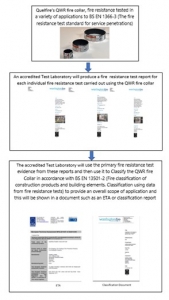What is a ‘tested solution’ for service penetrations? Firestopping FAQs
The simple answer is something that has been tested in accordance with, and proven to meet the requirements of, a relevant standard. However, there is no straightforward answer as there are several products such as fire collar, wraps, sleeves, and sealants which have been tested in varying applications with varying levels of ‘evidence’.
A passive fire protection product may be a ‘tested solution’ because it has a fire test report for a particular application, however, test reports for fire resistant products are fairly specialised, in-depth reading and only provide a snapshot in time of what was achieved in an individual test. This essentially means that ‘what you test, is what you get’ and any real-life changes in specification to the services or substrate, for instance, are not directly covered by the fire test report evidence.
Where a fire test report is the only available evidence and details differ from that tested, Quelfire would advise you to consult a qualified 3rd party, such as a fire engineer or an accredited test laboratory, to review all the fire test evidence available and see if a technical assessment can be conducted. If the 3rd party cannot justify a technical assessment, for example, if there is a lack of relevant primary fire test evidence or the situation differs too much from what is tested, then the onsite application would need to change to match an existing tested solution. Or, you would need to consider conducting an actual fire test of the specific scenario.
Classification reports, UKTAs or ETAs, are much more useful documents as they comprise of fire test evidence data from multiple, successful test reports and provide an overall scope of application that the product can be used in. These assessments are carried out by 3rd parties, usually an UKAS accredited organisation, in accordance with standards agreed across multiple laboratories. This means the data has effectively been subjected to more scrutiny than an individual test report.
> See also: What is the difference between a classification report and a test report?
For example, the QWR Fire Collar is extensively fire tested in a variety of applications to BS EN 1366-3 (the fire resistance test standard for service penetrations), for which there are many individual fire test reports.

The primary fire test evidence is then classified to BS EN 13501-2, which is the fire classification of construction products and building elements. The overall scope of application is then documented in a classification report and later, a UKCA or ETA.
Some products or applications cannot be classified due to lack of a standard or scope, so a fire test report might be the only document available to demonstrate a ‘tested solution’. But generally, this would be regarded as the bare minimum, as a classification report would have been reviewed by another qualified 3rd party to ensure your application meets this test report, considering all the factors and evidence involved.
Therefore, early engagement with firestopping manufacturers is key to ensure that all factors that directly affect the ‘tested solution’ have been considered. Also, so that the project construction can be compliant and the relevant level of documentation, to satisfy all parties, is available.
If you have any further questions, then please don’t hesitate to contact us.

